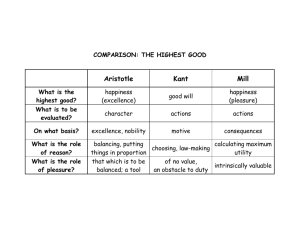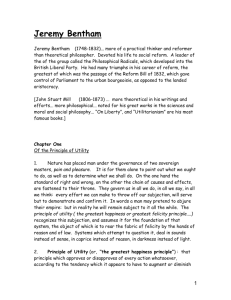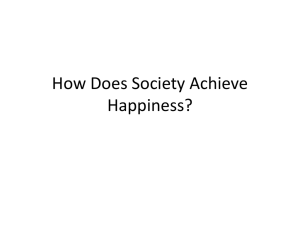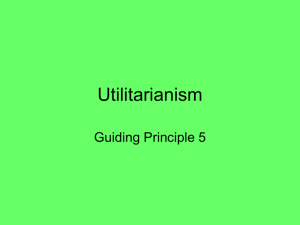File
advertisement
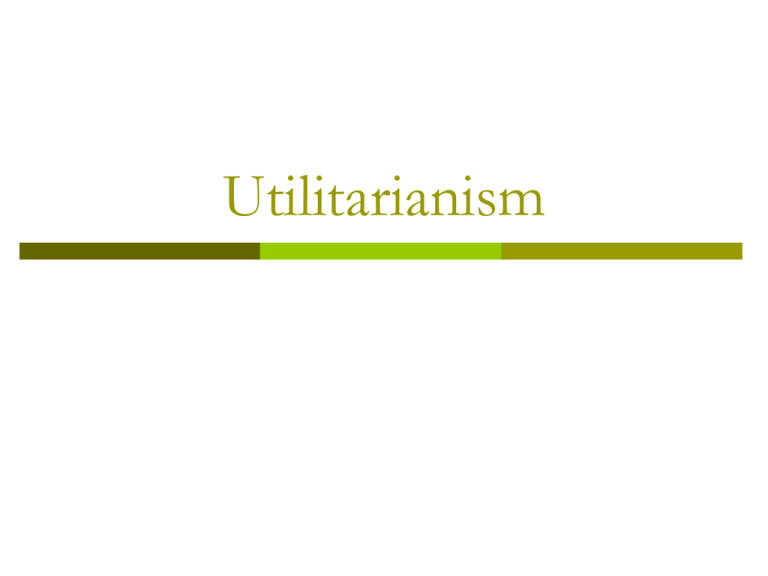
Utilitarianism Utilitarianism Learning Objectives:(long term) 1. 2. 3. 4. 5. To understand the ‘greatest happiness principle’. To understand the similarities and differences between Bentham and Mill. Understand the distinction between Act and Rule Utilitarianism. Discuss how appropriate these labels are for Bentham and Mill. Evaluate the strengths and weaknesses of Utilitarianism. This lesson’s objectives are… To understand the principle of utility. To be able to explain the significance of the hedonic calculus. To be confident with Jeremy Bentham’s utilitarianism theory. To understand what ‘Act Utilitarianism’ means. Utilitarianism- Key Points Brief Intro… A teleological theory. But, what does this mean? Teleological theories look at the consequences- the results of an actionto decide whether it is right or wrong. Consequentialist theory- someone who decides whether an action is good or bad by its consequences. Jeremy Bentham He was concerned with social and legal reform & he wanted to develop an ethical theory which established whether something was good or bad according to its benefit for the majority of people. He called this the principle of utility. Utility= the usefulness of the results of actions. 1 2 Bentham… Bentham equated happiness with pleasure and the absence of pain. This was an empirical observation - people desire pleasure and seek to avoid pain. His scientific mind led him to believe that the study of ethics could be undertaken in a practical way, carefully measuring the possible consequences or outcomes of an action before deciding which choice to take. Bentham’s theories led to extensive social reform affecting Parliament, criminal law, the jury system, prisons, savings banks, cheap postage etc, etc. What was revolutionary about Bentham’s theory was that it resulted in all people being considered when making laws. His hedonic calculus was especially helpful in determining how to measure different amounts of pleasure. Principle of Utility Often expressed as, “the greatest good of the greatest number”. Good = happiness or pleasure. So, an act is right or wrong according to the good or bad results that results from the act and the good act is the most pleasurable. Quantitative= focuses on the greatest number. Bentham’s Approach The theory is based on ancient hedonism, which pursued physical pleasure and avoided physical pain. Moral acts= maximise pleasure/ minimise pain Utilitarian calculus. So, an act = moral, if it brings the greatest amount of pleasure and least pain. Examples? Pain vs. pleasure Bentham, “The principle of utility aims to promote happiness which is the supreme ethical value. Nature has placed us under the governance of two sovereign masters, pain and pleasure. An act is ‘right’ if it delivers more pleasure than pain and ‘wrong’ if it brings about more pain than pleasure.” Simple equation Happiness = pleasure minus pain. Pleasure vs. Happiness “Actions are right in proportion when they tend to promote happiness, wrong when they tend to produce the reverse of happiness.” When Bentham talks about happiness, he refers to pleasure and the absence of pain; by unhappiness, pain and the privation of pleasure. According to Bentham's theory, the rightness of an action entirely depends on the value of its consequences. That is why the theory is also described as consequentialist. Hedonism HEDONISM Hedonism The view that pleasure is the chief ‘good’. Origins of Hedonism Utilitarianism a Hedonistic theory. This is based on the idea that ‘good’ is defined in terms of pleasure/ happiness. Greek Philosophers-- Plato and Aristotle both argued that ‘good’ equated with the greatest happiness. While Epicureans stressed pleasure as the main aim of life. Pleasure is NOT the same as happiness, as happiness results from the use of reason and cultivating the virtues. It is only if we take pleasure in good activities that pleasure itself is good. Measure Hedonism Think: If you were to measure pleasure (Hedonism), how would you do it? What would you look for? (5 minutes). Hedonic Calculus Helps us choose the good thing to do and work out the possible consequences of an action. P.R.R.I.C.E.D = acronym. Purity – how free from pain is it? Remoteness – how near is it? Richness – to what extent will it lead to other pleasures? Intensity – how powerful is it? Certainty – how likely it is to result in pleasure? Extent – how many people does it affect? Duration – how long will it last? Hedonic Calculus & Euthanasia Bentham's Hedonic Calculus can be used to weigh up the pleasure and pain caused by two courses of action - in this case, helping someone to die, or not doing so. Bentham would consider the Intensity of the pain and its Duration. He would have to weigh that against the number of people affected (Extent), and consider whether keeping someone alive would lead to other pleasures (Richness). He would also need to add up the amount of other 'pains' the patient would face e.g. loss of dignity (Purity), and consider the chances that there' might be a cure or treatment in the future (Certainty). The pain is immediate, while possible future benefits are Remote. In most cases, the degree of pain is so great that Bentham's theory would support euthanasia. Act Utilitarianism A teleological theory that uses the outcome of an action to determine whether it is good or bad. Thinking Points- Debate 1. 2. 3. 4. Are all actions only good because they have good results? Suppose a surgeon could use the organs of one healthy patient to save the lives of several others. Would the surgeon be justified in killing the healthy patient for the sake of the others? Suppose a rape is committed that is thought to be racially motivated. Riots are brewing that may result in many deaths and long term racial antagonism. You are the police chief and have recently taken a man into custody. Why not frame him? He will be imprisoned if found guilty and this will result in peace and safety. Only you, the innocent man and the real rapist (who will keep quiet), will know the truth. What is the morally right thing to do? You are an army officer who has just captured an enemy soldier who knows where a secret time bomb is planted. If it explodes it will kill thousands. Will it be morally permissible to torture the solider so that he reveals the bomb’s location? If you knew where the soldier's children were, would it also be permissible to torture them to get him to reveal the bomb’s whereabouts? Wrap up On the piece of paper, write one thing you have learned today… Could be a concept you are now familiar with. Or, a new key term in your vocabulary. A theory that you are more confident in understanding. Developed an academic/exam skill. If nothing, be honest. But say why you feel nothing.

